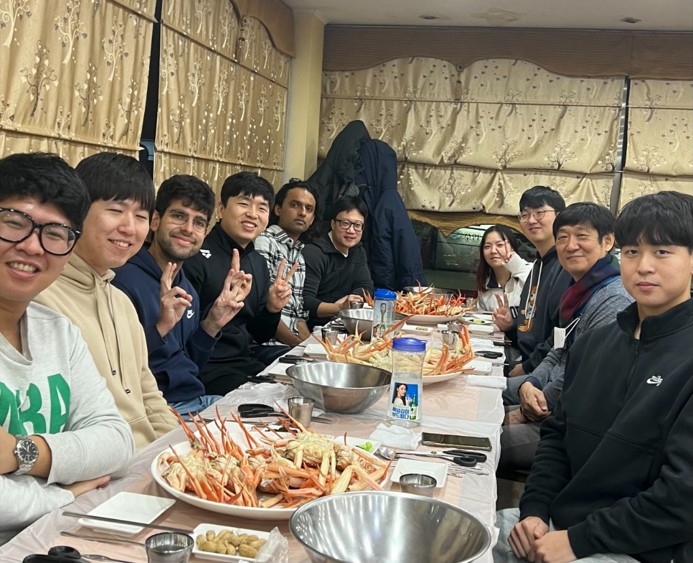Simon Gramatte - KR

What made you decide to apply for a grant at the Leading House Asia?
I am doing my Ph.D. in computational Materials Sciences. The main topic of my Ph.D. is the modeling of interfaces with complex chemical bonding, especially Al/Al2O3. The method I am focused on is called Molecular Dynamics (MD) Simulations. For MD simulations one of the most important tools one needs is the interatomic MD potential, which describes the interactions between the atoms am simulating. For complex interfaces not too many of those potentials are available. Prof. Byeong-Joo Lee's group are the main developers and sustainers of one type of those interatomic MD potentials. As I saw the advertisement for the grant, I thought that this would be a great opportunity to visit his group and learn how to develop/test/benchmark/use one of his MD potentials.
How did you secure a host professor?
After reading the Advertisement for the grant, I discussed it with my supervisor. My supervisor already had some loose contact with Prof. Lee and proposed to put me in contact with him. Therefore I drafted an Email for my supervisor explaining how the grant is working and what I would plan to research in South Korea. Prof. Lee was happy about the mail and answered that they were already working on something similar and therefore would be happy to support my application and host me in Korea. So that I was able to prepare the grant documents, where the email I wrote to Prof. Lee already was a good starting point.
How would you describe your experience of the programme?
The Group of Prof. Lee is doing group outings and dinners every three months. So during my stay, I was able to participate in two of their group dinners. Approaching the end of my stay the Prof. organized an early dinner in a king crab restaurant in the city center of Pohang. For me as a small-town boy from the countryside, it was fascinating and intimidating to see the gigantic crabs swimming in tanks before getting them served on a plate. To then learn how to eat them with scissors and bare hands from the professor, with the explanation that the parts that look the most disgusting are the best parts of such a king crab was unforgettable.
What role did the Leading House Asia play in the programme?
The leading house in Asia helped a lot with the organization. They provided us with the initial information for the Visa process, which was helpful. Furthermore, it put me in contact with the other grantees, the three of us always had almost the same problems as we started the program shifted by two weeks. Every time one of us experienced a problem the leading house tried to tackle it in advance for all the others of us that might experience the same problem.
What were the impacts you made through the project/partners/individual?
During my stay in the group Professor Lee's group for computational material sciences and engineering, I learned how to use the Korean group-developed FORTRAN MD code (KissMD). Making use of this code, I was able to run MD simulations using the so far unpublished, but by the Korean group already developed 2NNMEAM+Qeq MD potential for amorphous (am)-Al2O3. The potential then was utilized to calculate the force and energy values of am-Al2O3 structures.
I developed a workflow, that compares the energy and force values from DFT which the ones from the MD calculations.
To evaluate the performance of the 2NNMEAM+Qeq potential compared to other potentials, I developed a second workflow. This workflow uses LAMMPS a publicly available MD simulation software and can do energy and force calculations with a vast variety of potentials. The results of my study show, that potentials with the Qeq procedure, are performing better than potentials without Qeq. Especially the ReaxFF and 2NNMEAM potential reach almost DFT accuracy. The different potentials have different limits of applicability, which becomes visible when comparing the performance of the potentials on e.g. stoichiometry and density.
Furthermore, during the stay I developed a machine learning (ML) potential, using a recently developed algorithm.
Overall, the results look promising, the 2NNMEAM potential looks especially interesting for modeling am-Al2O3 at an interface with metal, especially Al. Unfortunately, the potential is not implemented in LAMMPS at the moment, which would boost its computational performance. Therefore this implementation might be the topic of future collaboration.
Testimonial: what were your personal experiences/thoughts on the bilateral cooperation experience?
I had a warm welcome at POSTECH. The group sent a Ph.D. student that picked me up at the entrance of the campus and helped me with the housing and showed me around.
I was living on campus in an international dormitory, sharing a room with a Korean student. This was a really special experience for me, and a situation I could not be able to handle without knowing it would just be for a limited time. It is fascinating that most Korean students live that way during all their studies.
The University offered 3 hot meals a day in the cafeteria, but after I got to know my lab mates they usually ordered delivery food for all of us, including me, or took me somewhere in the city for lunch and sometimes dinner. In general, the expected office hours are way longer than in Switzerland but for me, as an exchange, they were not too strict. Therefore I was able to leave earlier on Fridays to see a lot of the country over the weekends together with other exchange students or the other grantees that were based in other cities than me.